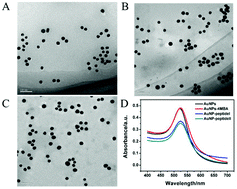AuNP-peptide probe for caspase-3 detection in living cells by SERS†
Abstract
Colloidal nanoparticles can be used as surface-enhanced Raman scattering (SERS) substrates because the very close spacing between particles existing in these colloidal systems is beneficial for the generation of extremely strong and highly spatially localized electric field enhancements. Herein, a caspase-3-specified peptide was used as a molecular cross-linker to engineer gold nanoparticle (AuNP) junctions in a controllable manner. The peptide was designed with a sequence of CCALNNPFFDVED (Cys-Cys-Ala-Leu-Asn-Asn-Pro-Phe-Phe-Asp-Val-Glu-Asp) or CCALNNKYDDVED (Cys-Cys-Ala-Leu-Asn-Asn-Lys-Tyr-Asp-Asp-Val-Glu-Asp), where the CALNN (Cys-Ala-Leu-Asn-Asn) fragment helps to stabilize AuNP suspension in aqueous media and the sequence of DVED (Asp-Glu-Val-Asp) can be cleaved by caspase-3. In addition, the PFF (Pro-Phe-Phe) or KYD (Lys-Tyr-Asp) was exposed and interacted via the hydrophobic or alternate negative and positive electro-interaction in the presence of caspase-3, inducing the aggregation of colloidal Au-peptides accompanied with the enhancement of SERS. It can be observed that the SERS-enhanced signals were correlated with the caspase-3 concentrations and the limit of detection can reach 1.5 ng mL−1. Finally, this caspase-3-specified AuNP-peptide probe has been found to be a promising candidate for its application in the analysis of caspase-3 in living cells.



 Please wait while we load your content...
Please wait while we load your content...